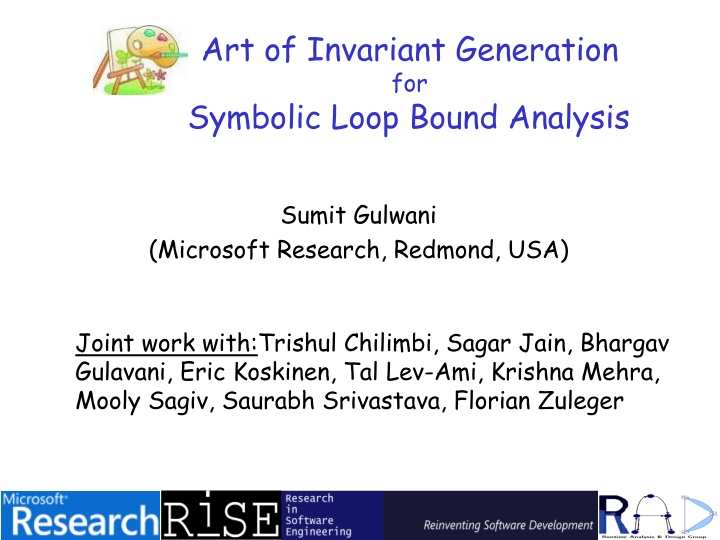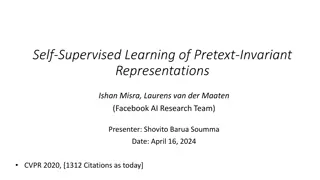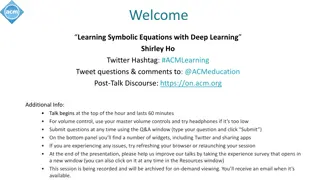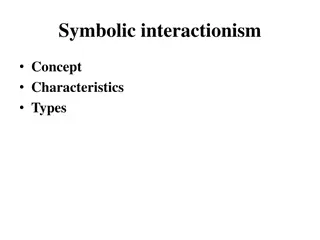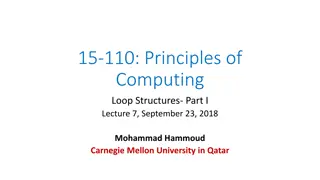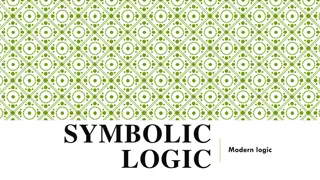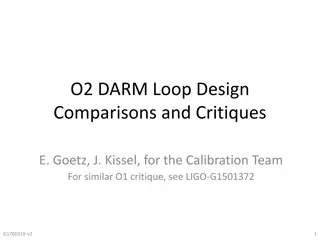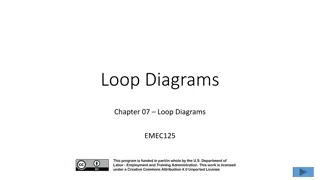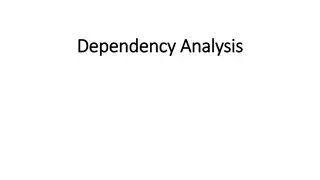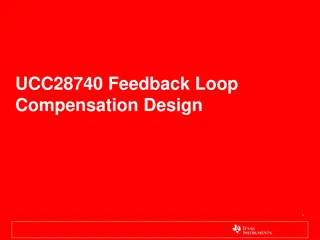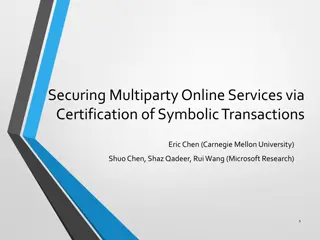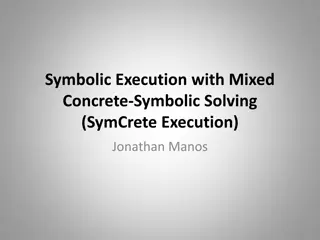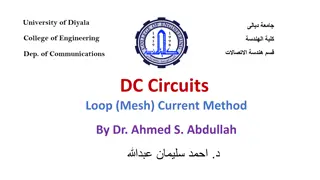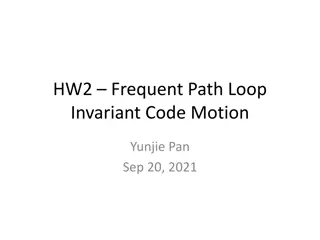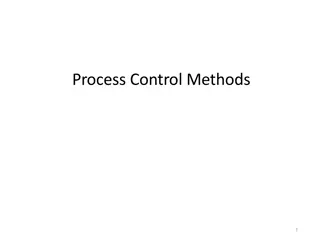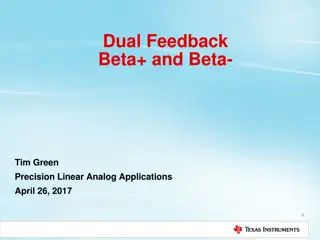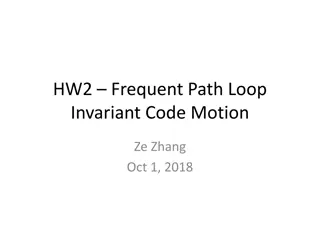Symbolic Loop Bound Analysis: Art of Invariant Generation
Innovative techniques for computing symbolic loop bounds through invariant generation. Learn about applications, challenges, and examples in this cutting-edge research field.
Download Presentation

Please find below an Image/Link to download the presentation.
The content on the website is provided AS IS for your information and personal use only. It may not be sold, licensed, or shared on other websites without obtaining consent from the author.If you encounter any issues during the download, it is possible that the publisher has removed the file from their server.
You are allowed to download the files provided on this website for personal or commercial use, subject to the condition that they are used lawfully. All files are the property of their respective owners.
The content on the website is provided AS IS for your information and personal use only. It may not be sold, licensed, or shared on other websites without obtaining consent from the author.
E N D
Presentation Transcript
Art of Invariant Generation for Symbolic Loop Bound Analysis Sumit Gulwani (Microsoft Research, Redmond, USA) Joint work with:Trishul Chilimbi, Sagar Jain, Bhargav Gulavani, Eric Koskinen, Tal Lev-Ami, Krishna Mehra, Mooly Sagiv, Saurabh Srivastava, Florian Zuleger
Problem Definition This talk: Given a loop, compute symbolic worst-case bounds on number of loop iterations (in terms of inputs). Harder than proving loop termination. Key Idea: Reduce problem to invariant generation. Extensions: Procedure bounds Amortized Bounds Recursive procedures, Concurrent procedures Variety of Resources (besides just time) Monotonic (e.g., time, n/w traffic) Non-monotonic (e.g., memory usage, call stack depth) Other kinds of bounds Average-case bounds, Lower bounds, Real time bounds 1/32
Applications Provide immediate feedback during code development Use of unfamiliar APIs Code Editing Performance Analysis Identify corner cases (unlike profiling) 2/32
Reducing Bound Analysis to Invariant Generation Inputs: int n c := 0; while cond do c := c+1; S while cond do S Claim: If c F(n) is a loop invariant, then Max(0,F(n)) is an upper bound on number of loop iterations. 3/32
Importance of Max Rule Claim: If c F(n) is a loop invariant, then Max(0,F(n)) is an upper bound on number of loop iterations. If we instead claim F(n) to be an upper bound, we get an unsound conclusion. Consider, for example: Test(int n1, int n2) int c1:=0; while (c1<n1) c1++; int c2:=0; while (c2<n2) c2++; c1 n1 is a loop invariant. Suppose we regard n1 to be an upper bound for first loop. (Similarly, for c2 and n2). Thus, n1+n2 is an upper bound for Test procedure. But this is clearly wrong when say n1=100 and n2=-100. 4/32
Example: Bound Analysis from Invariants Inputs: int n x := 0; y := n; c := 0; while (x < y) c := c+1; if (*) x := x+2; else y := y-2; Consider the inductive loop invariant: 2c = x+(n-y) x<y Projecting out x and y yields c n/2. Thus, Max(0,n/2) is an upper bound on loop iterations. 5/32
Challenges in Computing Required Invariants Challenge 1: Invariants required are often non-linear and disjunctive. When loops have control-flow inside them, which lead to bounds itself being disjunctive/non-linear. Challenge 2: Invariants reference numerical properties of (partitions of) data-structures (partition-size invariants). When loops iterate over data-structures. 6/32
Art of Invariant Generation for Bound Analysis 1. Program Transformations To enable generation of sophisticated invariants (on original program) from composition of simpler invariants (on transformed program). Non-linear/Disjunctive/Partition-size invariants from simple (linear) invariant generation tools. 2. Colorful Logic Invariant language + decision procedures to reason about formulas in that language. Non-linear/Disjunctive/Partition-size abstract domains (for programs where transformations don t help). 3. Fixpoint Brush For generating inductive loop invariants. 7/32
Art of Invariant Generation for Bound Analysis 1. Program Transformations Reduce need for disjunctive/non-linear invariants Multiple Counter Instrumentation (POPL 09a) Control Flow Refinement (PLDI 09a) Reduce need for partition-size invariants. Quantitative Attributes Instrumentation (POPL 09a) 2. Colorful Logic Partition-size Abstract Domain (POPL 09b) Non-linear Abstract Domain (CAV 08) 3. Fixpoint Brush Iterative (PLDI 06) Constraint-based (PLDI 08, PLDI 09b) Pattern Matching (Ongoing work) 8/32
Example: Loop with disjunctive bound Inputs: int n, x0, z0 c := 0; x := x0; z := z0; while (x<n) c++; if (z>x) x++; else z++; Inputs: int n, x0, z0 c1 := 0; c2 := 0; x := x0; z := z0; while (x<n) if (z>x) x++; c1++; else z++; c2++; Loop has disjunctive bound Max(0,n-x0) + Max(0,n-z0). Single counter requires disjunctive invariants. Use of multiple counters (different counters for different paths) facilitate bound computation using linear invariants. c1 n-x0 . Thus, # of executions of if-branch: Max(0,n-x0) c2 n-z0 . Thus, # of executions of else-branch: Max(0,n-z0) Therefore, total # of iterations: Max(0,n-x0) + Max(0,n-z0)9/32
Example: Loop with polynomial bound Inputs: uint n.m x:=0; y:=0; Inputs: uint n.m x:=0; y:=0; c1 := 0; c2 := 0; while (x<n) if (y<m) y++; c1++; else y:=0; x++; c2++; else y:=0; x++; Inputs: uint n.m x:=0; y:=0; c1 := 0; c2 := 0; while (x<n) if (y<m) y++; c1 ++; else y:=0; x++; c2++; c1 :=0; while (x<n) if (y<m) y++; Loop has polynomial bound (1+m)*(1+n). c2 n. Thus, # of executions of else-branch: n Bound on c1 (# of executions of if-branch) is non-linear. c1 m. Thus, # of executions of if-branch in between any two executions of else-branch: m Therefore, Total # of iterations: (1+m)*(1+n) 10/32
Automating Multiple Counter Instrumentation Track each acyclic path (inside a loop) with a separate counter. Challenge: Decide the locations where to re-initialize a given counter to 0. Key Idea: Re-initializing a counter to 0 increases ability of an invariant generator to discover bound on the counter. But can t simply re-initialize every counter to 0 on all other paths as it creates circular dependencies between counters. Paper describes an appropriate algorithm that is quadratic (in # of paths in the loop). 11/32
Art of Invariant Generation for Bound Analysis 1. Program Transformations Reduce need for disjunctive/non-linear invariants Multiple Counter Instrumentation (POPL 09a) Control Flow Refinement (PLDI 09a) Reduce need for partition-size invariants. Quantitative Attributes Instrumentation (POPL 09a) 2. Colorful Logic Partition-size Abstract Domain (POPL 09b) Non-linear Abstract Domain (CAV 08) 3. Fixpoint Brush Iterative (PLDI 06) Constraint-based (PLDI 08, PLDI 09b) Pattern Matching (Ongoing work) 12/32
Example: Loop with multiple phases Inputs: int n, m Assume(0<n<m) x := n+1; while (x n) if (x m) x++; else x := 0; x := n+1; while (*) P1: assume(x n x m); x++; P2: assume(x n x>m); x:=0; Transition System Representation Control Flow Refinement x := n+1; while (*) {assume(x n x m); x++;} assume(x n x>m); x:=0; while (*) {assume(x n x m); x++;} Control-flow Refinement: Transform a loop with multiple paths into code-fragment with simpler loops. For above example, (P1 | P2)* reduces to P1+ P2 P1+. This implies a bound of (m-n)+(1)+(n) = m+1 13/32
Control-Flow Refinement Recall algebraic equivalence: (P1|P2)* = Skip | (P1|P2) (P1|P2)* Used by iteration based tools to compute fixed-points. Now consider a different algebraic equivalence: (P1|P2)* = Skip | P1+| P2+| P1+ P2 (P1|P2)* | P2+ P1 (P1|P2)* Here the focus is on action when P1 and P2 interleave. 1. Expand a loop (P1 | P2)* using the above rule. 2. Use an invariant generation tool to check feasibility of above cases and accordingly expand recursively. The expanded code-fragment with simpler loops is easier to analyze. Invariants of simpler loops correspond to disjunctive invariants over the original loop. 14/32
Art of Invariant Generation for Bound Analysis 1. Program Transformations Reduce need for disjunctive/non-linear invariants Multiple Counter Instrumentation (POPL 09a) Control Flow Refinement (PLDI 09a) Reduce need for partition-size invariants. Quantitative Attributes Instrumentation (POPL 09a) 2. Colorful Logic Partition-size Abstract Domain (POPL 09b) Non-linear Abstract Domain (CAV 08) 3. Fixpoint Brush Iterative (PLDI 06) Constraint-based (PLDI 08, PLDI 09b) Pattern Matching (Ongoing work) 15/32
Example: Loop iterating over a data-structure BreadthFirstTraversal(List L): ToDo.Init(); L.MoveTo(L.Head(),ToDo); c:=0; while (! ToDo.IsEmpty()) c++; e := ToDo.Head(); ToDo.Delete(e); foreach successor s in e.Successors() if (L.contains(s)) L.MoveTo(s,ToDo); Bound may require reference to quantitative attributes of a data-structure. E.g., Len(L): Length of list L. Inductive Invariant for the outer while-loop c Old(Len(L)) - Len(L) Len(ToDo) Len(L) 0 Len(ToDo) 0 This implies a bound of Old(Len(L)) for while loop. 16/32
User-defined Quantitative Attributes User describes semantics of quantitative attributes by stating how they are updated by various data-structure methods. Data Structure Operation L.Delete(e); L.MoveTo(e,L ); Updates to Quantitative Functions Len(L)--; Len(L)--; Len(L )++; Paper gives examples of quantitative attributes for trees, bit-vectors, composite structures (e.g., list of lists) Trees: Height, Number of nodes Bit-vectors: Number of 1 bits List of lists: Sum of # of nodes in all nested lists. 17/32
Art of Invariant Generation for Bound Analysis 1. Program Transformations Reduce need for disjunctive/non-linear invariants Multiple Counter Instrumentation (POPL 09a) Control Flow Refinement (PLDI 09a) Reduce need for partition-size invariants. Quantitative Attributes Instrumentation (POPL 09a) 2. Colorful Logic Partition-size Abstract Domain (POPL 09b) Non-linear Abstract Domain (CAV 08) 3. Fixpoint Brush Iterative (PLDI 06) Constraint-based (PLDI 08, PLDI 09b) Pattern Matching (Ongoing work) 18/32
Example: Loop requiring partition-size invariants BubbleSort (int[] A, int n): change := true; c := 0; while (change) c := c+1; change := false; for (j:=0; j<n-1; j++) if (A[j]>A[j+1]) {swap(A[j],A[j+1]); change := true;} From the inductive loop invariant c size(Asorted) where A = AsortedU Aunsorted we can deduce a bound of n 19/32
Design of a Partition-Size Abstract Domain Modular construction of new logical domain, from a given set/partition domain and a numerical domain. Set/Partition Domain Tracks sets of memory locations E.g., Canonical Abstraction [SRW 02], Separation Domain [DOY 06], Boolean Heaps [PW 05] Numerical Domain Track sizes and correlations with numerical variables E.g., Polyhedra [CH 78], Octagon [Min 01], Intervals [CC 07] Key Idea: Construct decision procedure for new logical domain using decision procedures for constituent domains, akin to Nelson-Oppen combination procedure. But more challenging since domains aren t disjoint, and hence need to share more than variable equalities. 20/32
Art of Invariant Generation for Bound Analysis 1. Program Transformations Reduce need for disjunctive/non-linear invariants Multiple Counter Instrumentation (POPL 09a) Control Flow Refinement (PLDI 09a) Reduce need for partition-size invariants. Quantitative Attributes Instrumentation (POPL 09a) 2. Colorful Logic Partition-size Abstract Domain (POPL 09b) Non-linear Abstract Domain (CAV 08) 3. Fixpoint Brush Iterative (PLDI 06) Constraint-based (PLDI 08, PLDI 09b) Pattern Matching (Ongoing work) 21/32
Example: Loop with non-linear bound Inputs: int y0, int n x := 0; y := y0; c := 0; while (x<n) c := c+1; x := x+y; y := y+1; Termination proof: lexicographic polyranking fns From inductive loop invariant y2=y02 + 2x c=y-y0 x<n we can deduce bound of sqrt{2n}+max(0,-2y0)+1 22/32
Design of a Non-linear Abstract Domain View a non-linear relationship 3log x + 2x 5y over {x,y} as a linear relationship over {log x, 2x, y} User provides semantics of non-linear operators using directed inference rules of form L ) R Exponentiation: e1 e2+c ) 2e1 2e2 2c Logarithm: e1 ce2 0 e1 0 e2) log(e1) log c + log(e2) Multiplication: e1 e2+c e 0 ) ee1 ee2+ec If we deduce a fact of form L (using linear reasoning), we assert the corresponding fact R. Key Idea of Expression Abstraction: Restrict new fact deduction to a small set of expressions, either given by user or constructed heuristically from program syntax. 23/32
Art of Invariant Generation for Bound Analysis 1. Program Transformations Reduce need for disjunctive/non-linear invariants Multiple Counter Instrumentation (POPL 09a) Control Flow Refinement (PLDI 09a) Reduce need for partition-size invariants. Quantitative Attributes Instrumentation (POPL 09a) 2. Colorful Logic Partition-size Abstract Domain (POPL 09b) Non-linear Abstract Domain (CAV 08) 3. Fixpoint Brush Iterative (PLDI 06) Constraint-based (PLDI 08, PLDI 09b) Pattern Matching (Ongoing work) 24/32
Iterative Fixpoint over Linear+Uninterpreted Fns. Need to provide Join and Widen transfer functions. Join: Merge facts at control location Widen: Overapproximate at loop headers for convergence. Paper describes construction for JoinD1+D2 using JoinD1 and JoinD2 as black-boxes. Analogous to Nelson-Oppen construction of DecideD1+D2 from DecideD1 and DecideD2, but more challenging! JoinLINEAR described in [Cousot, Halbwachs, POPL 78]. JoinUNINTERPRETED FNS described in [Gulwani, Necula, SAS 04]. Similarly for Widen 25/32
Art of Invariant Generation for Bound Analysis 1. Program Transformations Reduce need for disjunctive/non-linear invariants Multiple Counter Instrumentation (POPL 09a) Control Flow Refinement (PLDI 09a) Reduce need for partition-size invariants. Quantitative Attributes Instrumentation (POPL 09a) 2. Colorful Logic Partition-size Abstract Domain (POPL 09b) Non-linear Abstract Domain (CAV 08) 3. Fixpoint Brush Iterative (PLDI 06) Constraint-based (PLDI 08, PLDI 09b) Pattern Matching (Ongoing work) 26/32
Constraint-based Fixpoint over Arithmetic User provides templates for invariants (e.g., some boolean combination of a0+ iaixi 0). The trick now is to generate constraints over ai s that establish inductiveness of the invariant. The constraints are then solved for ai s using off- the-shelf constraint solvers. There is no iteration. This technique is especially suited for bound analysis since we are looking for invariants of the form c Function(inputs) 27/32
Art of Invariant Generation for Bound Analysis 1. Program Transformations Reduce need for disjunctive/non-linear invariants Multiple Counter Instrumentation (POPL 09a) Control Flow Refinement (PLDI 09a) Reduce need for partition-size invariants. Quantitative Attributes Instrumentation (POPL 09a) 2. Colorful Logic Partition-size Abstract Domain (POPL 09b) Non-linear Abstract Domain (CAV 08) 3. Fixpoint Brush Iterative (PLDI 06) Constraint-based (PLDI 08, PLDI 09b) Pattern Matching (Ongoing work) 28/32
Pattern-Matching Based Technique Bounds for a loop with a single/similar paths T can be computed most efficiently using a few patterns/rules. Program Transformation techniques are used to translate multi-path loops into single-path loops. If T )e > 0 and e[X /X] e-1, then Bound(T) is e. If T )e > 1 and e[X /X] e/2, then Bound(T) is log(e). If T T = false, then Bound(T) is 1. Examples flag flag =false 1 i i+1 i<n n-i i =2*i i<n log(n/i), provided i 1 i 0 i =i<<1 32 y Null y = y.Next Length(y), provided y is acyclic 29/32
Recurrence Solving Techniques vs. Our Fixpoint Brush Recurrence Solving Techniques vs. Our Fixpoint Brush Undergraduate Textbook on Algorithms by Cormen, Leiserson, Rivest, Stein describes 3 fundamental methods for recurrence solving: Example of a recurrence: T(n)=T(n-1)+2n T(0)=0 Iteration Method Expands/unfolds the recurrence relation Similar to Iterative Fixpoint Substitution Method Assumes a template for a closed-form Similar to Constraint-based Fixpoint Masters Theorem Provides a cook-book solution for T(n)=aT(n/b)+f(n) Similar to Pattern Matching 30/32
SPEED tool Implements following design choices. Non-trivial program transformations + Linear arithmetic + Pattern matching Built over Phoenix Compiler Infrastructure Can handle C++ source code, C++/.Net binaries Uses Z3 SMT solver as the logical reasoning engine. Can reason about loops that iterate using arithmetic, bit-vector, boolean, list/collection variables. Success ratio of 60-90% for computing loop bounds. Some representative failure cases (because of current lack of inter-procedural reasoning): for (i:=0; i<n; i := i+g) for (i:=0; i g; i := i+1) for (i:=0; i<n; i := P(i)); 31/32
Conclusion Bound Analysis An application area waiting to benefit from advances in invariant generation technology. Several important/open/challenging problems Concurrent Procedures, Average-case Bounds Art of Invariant Generation Program Transformations + Colorful Logic + Fixpoint Brush Abstract Interpretation/Data-flow Analysis/Model Checking None + Analysis-specific + Iterative An effective design choice for bound analysis Non-trivial transformations + Linear arith + Pattern Matching SMT solvers perform precise reasoning of loop-free code. Pattern Matching performs role of inductive reasoning. 32/32
